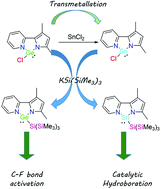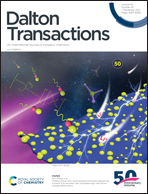Pyridylpyrrolido ligand in Ge(ii) and Sn(ii) chemistry: synthesis, reactivity and catalytic application†
Abstract
In our previous communication, we have reported the synthesis of a new chlorogermylene (B) featuring a pyridylpyrrolido ligand. This study details the preparation of a series of new germylenes and stannylenes starting from B. A transmetallation reaction between B and SnCl2 led to the analogous chlorostannylene (1) with the simultaneous elimination of GeCl2. This is a very unusual example of transmetallation between two elements of the same group. The preparation of 1via lithiation led to the formation of 2 as a side product, where the ortho C–H bond of the pyridine ring was activated and functionalized with a nBu moiety. Subsequently, B and 1 were used as precursors to generate germylene (4) and stannylene (5) featuring tris(trimethylsilyl)silyl (hypersilyl) moieties. We also prepared tetrafluoropyridyl germylene (6) by reacting 4 with C5F5N with the simultaneous elimination of (Me3Si)3SiF by utilizing the fluoride affinity of the silicon atom. As there is scarcity of Sn(II) compounds as single-site catalysts, we investigated 5 as a catalyst towards the hydroboration of aldehydes, ketones, alkenes and alkynes. All the compounds have been characterized by single-crystal X-ray diffraction and by state of the art spectroscopic studies.

- This article is part of the themed collection: Tin: Modern chemistry of an element from antiquity


 Please wait while we load your content...
Please wait while we load your content...